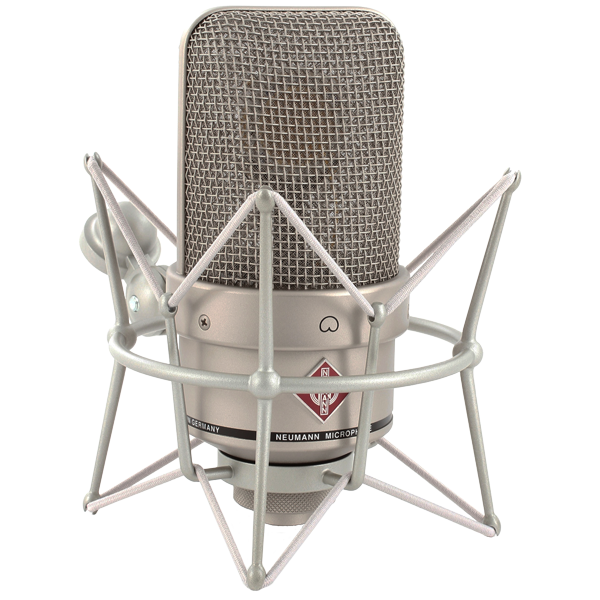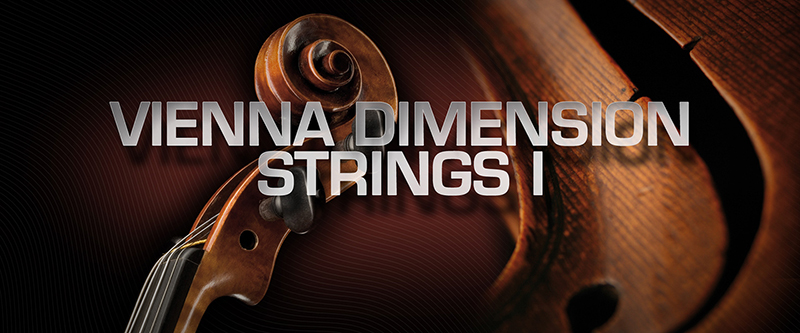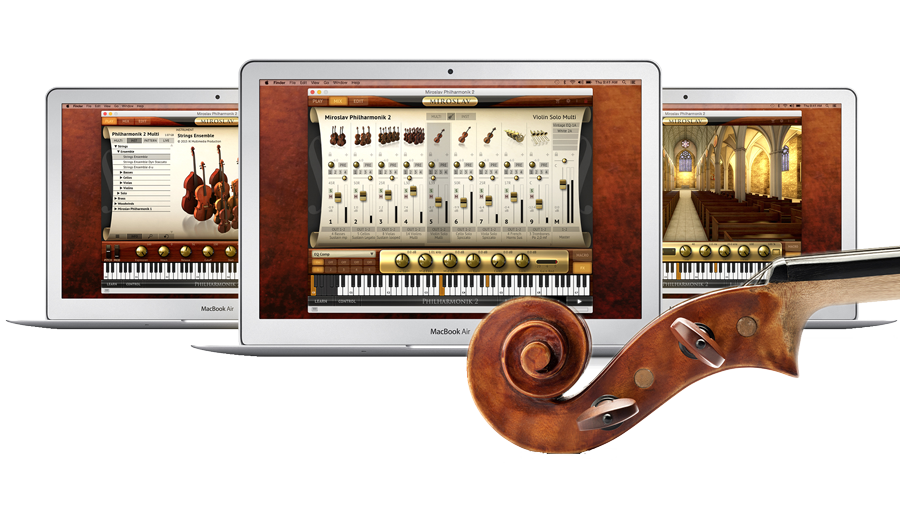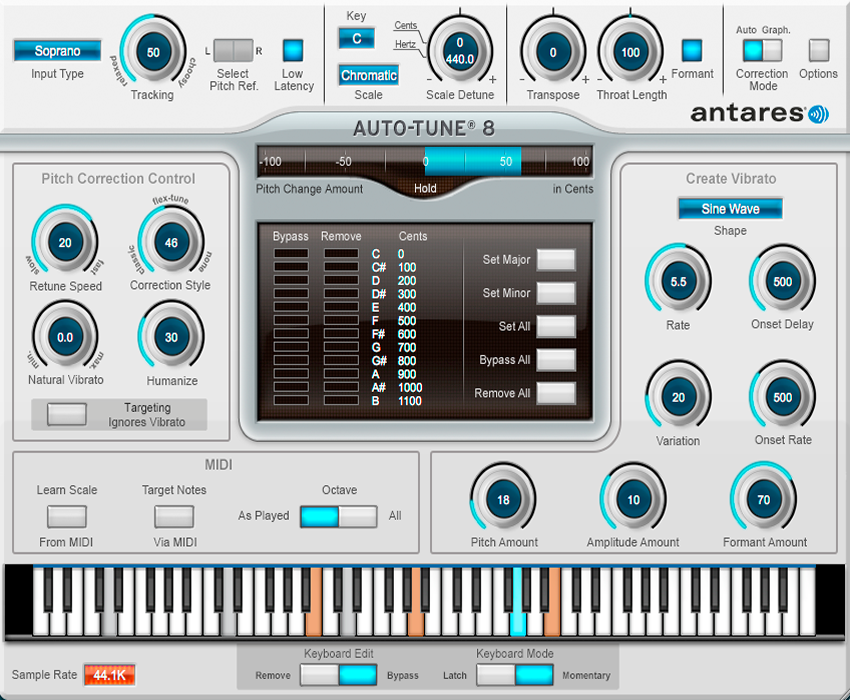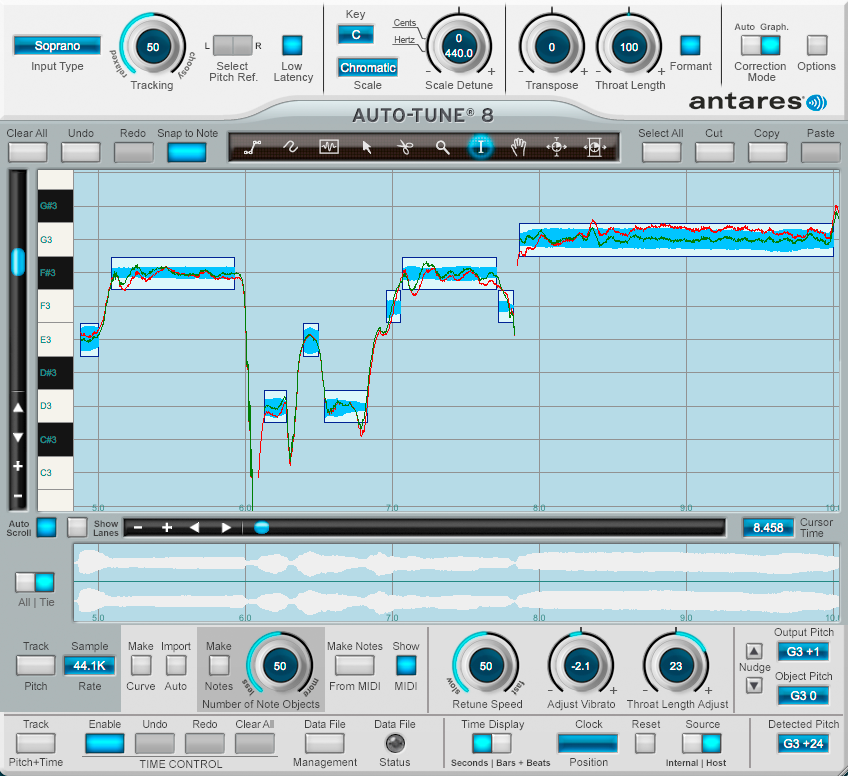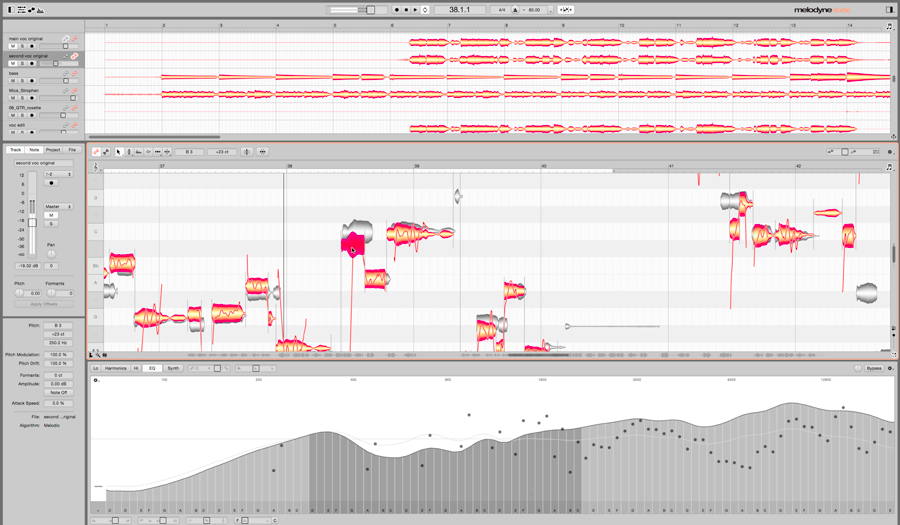News archive 2016
![]()
December 27, 2016
![]()
In memoriam
Georgios Kyriacos Panagiotou
(George Michael)
June 25, 1963 - December 25, 2016
And right at the end of 2016 I need to write a 7th obituary for the death of a great artist ...
If like me you grew up in the 80s and 90s when Michael Jackson was the American "King of Pop", then George Michael was undoubtedly the only real British "King of Pop". Not only as a singer of Wham! but also as a solo artist. He had a beautiful voice in perfect control. But also as a composer and arranger, he was a master of his craft, because almost everything he ever released was written by him and approached perfection. And live on stage this was no different.
I must admit that my preference is generally given to more alternative types of music, but I have always greatly admired George Michael for his skills and it's exactly this kind of craftsmanship that is becoming so rare. And especially after the merciless massacre of 2016 with the loss of so many great artists this is becoming more clear as ever...
So, can we now agree on that from 2017 on only assholes and suppliers of bad music will die?
![]()
November 11, 2016
![]()
In memoriam
Leonard Cohen
September 21, 1934 - November 07, 2016
This is the sixth time this year I have to write an obituary for the death of a great artist... It does not stop...
I read an obituary online in the Washington Post, it is written in the title: "Leonard Cohen, singer-songwriter of love, death and philosophical longing" and this I find a very apt description. Because when I look at my own life his songs have always been the most prominent in times of love, death and philosophical desire.
Besides, if a singer-songwriter had to get the Nobel Prize for literature, I had found Leonard Cohen a much better choice than Bob Dylan. Leonard Cohen was a poet in the true sense of the word.
![]()
October 17, 2016
![]()
In autumn all birds in the studio lay...

MunroSonic - EGG 100 Monitor System - Red
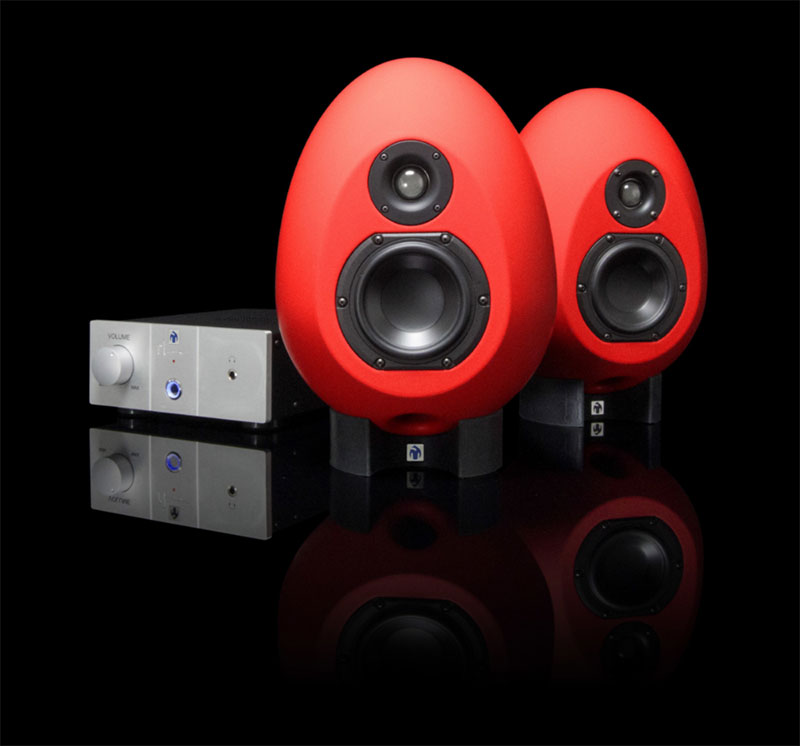
In autumn all birds in the studio lay a bright red egg!
You have to admit it: the design of these speakers is superb. They sound especially good and they fit into the range of studio monitors already present in the studio, so the decision to buy them to was made quickly.
These (passive) speakers with associated amplifier were designed by Andy Munro. He is known worldwide as an acoustic designer of sound recording studios (he is the founder of Munro Acoustics), as a designer of speakers (he co-founded Dynaudio Acoustics) and now as co-founder of MunroSonics to launch its own speaker designs.
He started with the EGG 150, a revolutionary design of an egg-shaped speaker that is especially suited as a midfield monitor (available in black or white). Some time ago the EGG 100 became available. This is a slightly smaller version than the EGG 150, specifically suited for nearfield monitoring at lower volumes. These exist in black, white and red and especially this last color I find particularly successful, you can not enter the studio without them catch the eye.
Frankly I tested the EGG 100 system initially because they are beautiful, but soon I found out they sound very good too. The egg-shaped speaker enclosure does not have hard reflections inside or around the speakers and this results in a very stable and phase-pure soundfield. The corresponding amplifier is specifically designed for this type of speakers and the amplifier has been manually adjusted to the supplied speakers. It is therefore not possible to replace one loudspeaker and/or the amplifier, if necessary, the entire system must be replaced,
So it is a monitoring system for more subtle music genres that require special attention to sonic details and a balanced sound. I have them a few weeks now and they continue to amaze me, especially on how well they complement my Genelec monitors.
Actually this is not the only addition to the arsenal of speakers in the studio, I also added this set:

AVANTONE PRO - Active MixCubes - Limited Edition Black
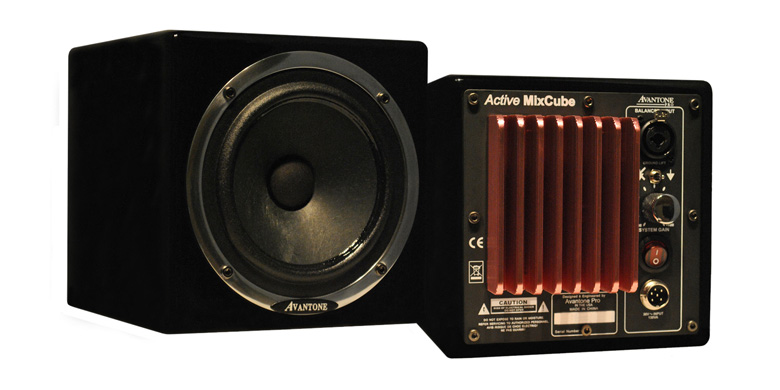
They are small... and sound very bad... in other words, so perfectly suited for use in an audio recording studio!
This is not a joke, on the contrary, I already have a set of speakers that I use specifically to hear how something sounds on shitty PC speakers (a set of Logitech - Z130, the best-selling PC speaker in the world)...
And I also have an old set of legendary YAMAHA NS-10M speakers from the 80s who do not sound that good either, they imitate in a professional way the sound of typical speakers on a bookshelf ...
And this set AVANTONE PRO - Active MixCubes - Limited Edition Black are situated somewhere between the two and imitate a small broadband loudspeaker from an old radio or television...
As a matter of fact these AVANTONE PRO MixCubes are very similar to the legendary Auratone 5C speakers from the 60s, 70s and 80s:
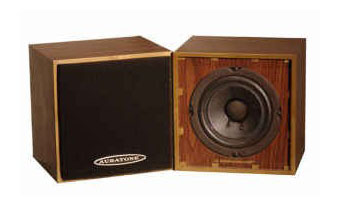
In those days these speakers were present in every recording studio and were used to evaluate a music mix on small speakers with little or no bass and treble. They sound so bad that they mockingly were called the "horror stones 'or' awfultones, but they were incredibly popular. It is eg. still said Quincy Jones made all mixes for Michael Jackson's album "Thriller" on Auratone 5C speakers and this is still the biggest selling album in history. But eg. the soundtrack for Saturday Night Fever by the Bee Gees was mixed to these speakers along with many other highly successful albums of that period
But ultimately Auratone stopped his activity as Jack Wilson, the founder of the company, deceased in 2005.
Soon Auratones became rare and second-hand prices began to ascend. AVANTONE PRO noticed this and issued its own version of the Auratone 5C, the MixCubes (as well as passive loudspeaker and an active version with built-in amplifier). They are very faithful to the original, but made with modern materials, making them much more durable than the original version. Also, the frequency spectrum and characteristics were simulated as much as possible, with a very good "bad sounding" result.
I opted for the limited shiny black version of the AVANTONE PRO MixCubes with built-in amplifier, black because I do not like the original color (creamy white) and amplified because this is just very convenient to use.
For your information: the heirs of Jack Wilson, the founder of the Auratone company, have recently started a new business and have also released a new version of the Auratone 5C: the Auratones 5C Super Sound Cube. But... many independent listening texts show this new version sounds 'too good'. There is more bass and treble present than in the original and that's just not the intention. The listening and comparisation texts also showed the AVANTONE PRO MixCubes really are most faithful to the original. Therefore I have chosen to buy the Avantove MixCubes and not the recent Auratones 5C Super Sound Cube.
With these two new sets the monitoring in the studio is complete. The most important monitors in the studio still remain all Genelec speakers, that speaks for itself.
This is an overview of all available monitors in the studio (they are all permanently installed and working):
Main 2.0 Stereo
- Genelec - 8050B Bi-Amplified Monitor System
Nearfield 2.1 Stereo + 5.1 Surround
- Genelec - 8130A Bi-Amplified Monitor System + 7060A Active Sub Woofer
Nearfield 2.0 Stereo - Set #1
- MunroSonic - EGG 100 Monitor System - Red
Nearfield 2.0 Stereo - Set #2
- YAMAHA - NS 10M Studio
Nearfield 2.0 Stereo - Set #3
- AVANTONE PRO - Active MixCubes - Limited Edition Black
Nearfield 2.0 Stereo - Additional Set #1
- Genelec - 8020A Bi-Amplified Monitor System
Nearfield 2.0 Stereo - Additional Set #2
- Genelec - 8010A Bi-Amplified Monitor System
Nearfield 2.0 Stereo - Additional Set #3
- Logitech - Z130
It has become a long list, For clarity, I have created a separate equipment list just for studio monitoring (speakers, headphones and accessories):
![]()
August 29, 2016
![]()
New to the guitar collection:
a special satin finished guitar...
with a heart of aluminum and chrome...

Fender - Standard Series - Stratocaster® Satin - Candy Apple Red MN - 60th Anniversary Edition - custom upgraded with Lace Alumitone pickups and chrome hardware
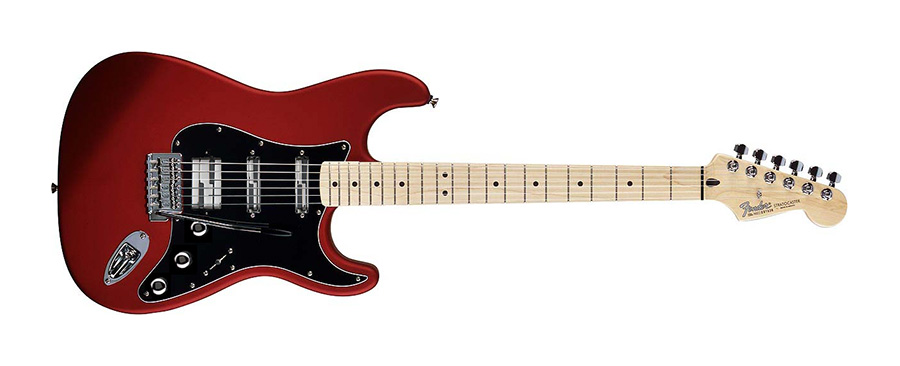
Unlike all the other guitars in my guitar collection this is not a newly acquired guitar but one that I have bought used some time ago over the Internet. I'm actually not a fan of used guitars, but from the moment I saw pictures of this guitar on a used musical instruments site, I knew that this guitar was something special.
It was not so much the guitar itself that appealed to me (it is just a standard Fender Stratocaster and I already have a few of them), it was the special appearance of this guitar. The official name of this model is 'Standard Stratocaster® Satin', so this is not a typical, very shiny guitar, on the contrary, it is a very nice version painted in matte satin. The color is "Candy Apple Red" and is frequently used by Fender, but it is very rare to see this color in matte satin. This is the official photo by Fender of the guitar that I bought:
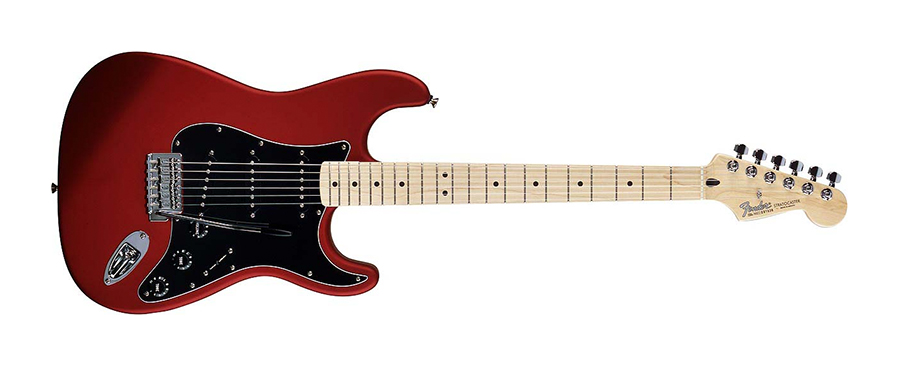
But to be able to see the difference between a Fender - Standard Series - Stratocaster® - Candy Apple Red MN and a Fender - Standard Series - Stratocaster® Satin - Candy Apple Red MN I made this photo-montage (left = standard, right = satin):

The difference between the pictures above might not be very large, but in reality if you keep them next to each other the difference is very noticeable! As a matter of fact the Fender - Standard Series - Stratocaster® Satin is very rare, they were up for sale only in 2006 to mark the 60th anniversary of Fender.
In 2006 the available satin colors were Gun Metal Blue, Midnight Wine, Candy Apple Red and Midnight Blue, as shown below:
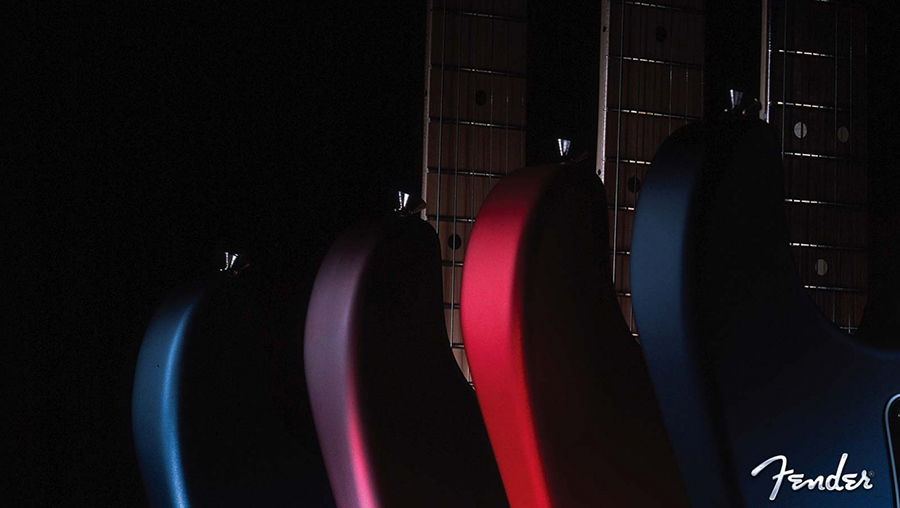
In 2013 there was also an FSR (Factory Special Run) with again a limited supply of satin colors. This run included 4 x Fender FSR Standard Stratocaster® Satin model and also 4 x Fender FSR Telecaster® Satin model in the more exotic looking satin colors Arizona Sun, Ocean Blue Candy, Blaze Gold and Flame Orange, as shown below (each model was available in each color):
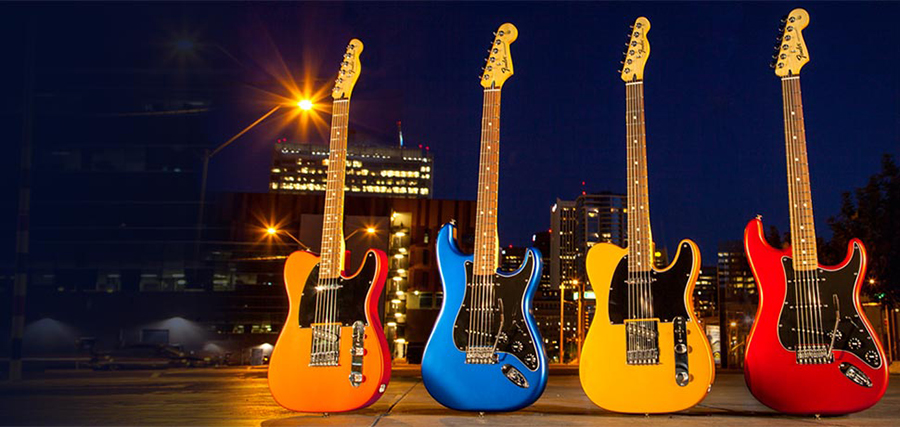
Personally I like the original colors from 2006 much more then the FSR colors from 2013, especially the 2006 Candy Apple Red Satin that I like very much, so I could not be happier with the purchase of this guitar.
So far the guitar itself...
Once I had the guitar in my possession I noticed the cosmetic condition was still as good as brand new, it was clear the original owner took very good care of his guitar. Then I began to think about what I could do best with this guitar. The first thing I noticed was the very beautiful contrast between the matte satin body, the chrome metal parts and the shiny black pickguard. Secondly, I found it very important that this guitar would be a definite addition to my guitar collection in terms of technical characteristics and of course also in terms of sound palette.
After a long search, I then found next solution:
- installing 2 x Lace Alumitone Single Coil pickups (chrome version)
- installing 1 x Lace Alumitone Humbucker pickup (chrome version)
- replacing the standard SSS pickguard by a custom HSS pickguard and making the pickup holes square shaped so the Lace Alumitones would fit
- replacing the black plastic knobs by 'chrome dome' knobs
- and as icing on the cake I also replaced the black plastic knob on the pickup selector by a chrome metal one
In appearance the design is at least very successful, the additional chrome elements accentuate even more the contrast between the matte body and all the shiny parts.
I also replaced the standard white plastic nut at the top of the neck by a black Graph Tech Black TUSQ XL guitar nut. This nut has been impregnated with PTFE lubricant, so there is no more friction between the strings and the nut, this helps bending the strings better and improves the tuning stability when using the tremolo bar. Due to it's specific composition the nut provides a better sound (more harmonics and longer sustain) and a much better overall tuning stability.
Also the internal electronics were replaced by Bourns Pro Audio pots and an Oak / Grigsby five way switch
But also in terms of sound, this guitar has become very special and this is mainly due to the use of Lace Alumitone pickups (see picture below, these are chrome versions of a single coil and a humbucker, as used in the guitar, but they are available in a lot of different finishes, colors and types)
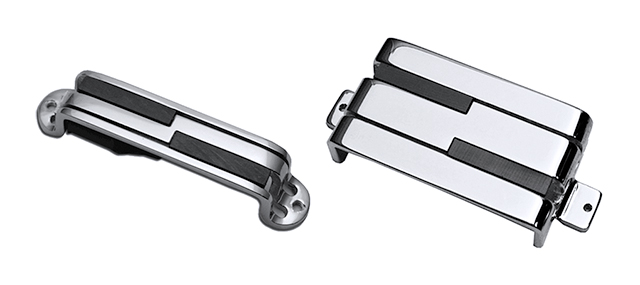
These pickups are a radical new design by Don Lace from Lace Pickups in Cypress, California USA. They are almost entirely made of aluminum and operate by an entirely different principle than conventional pickups. In an ordinary pickup one or several magnets are wound with many turns of copper wire, when a steel guitar string vibrates within the magnetic field of the pickup a little bit of electricity is being produced (expressed in Volts) ultimately reinforced many times through a guitar amp. With Lace Alumitones this is not the case, Here two magnets are wound by one thick aluminum wire (= the entire aluminum frame of the pickup) and it is the amount of current flowing (expressed in Ampère) which is then converted by a transformer in a voltage ultimately reinforced many times through a guitar amp.
The consequences of this revolutionary design are improvements such as they are absolutely free of noise so they can't hum, the frequency spectrum is much wider than a standard guitar pickup (thus more bass and treble) and this frequency spectrum is also much flatter. A good comparison is that a standard guitar pickups is an old standard TV with a low image resolution and a Lace Alumitone is a modern HD TV with a much better picture. So these pickups do not produce the very well known standard Stratocaster® single-coil sound with lots of mids, they produce a much more balanced and defined sound. You can even connect this guitar with an acoustic guitar amp and it will sound like an acoustic/electric guitar, try that with an ordinary Stratocaster®.
This guitar is therefore ideal for a clean guitar sound, but also for extremely distorted heavy-metal sounds. Due to the higher definition of the wider and flatter frequency spectrum of the Lace Alumitones the tonal content of distorted guitar chords is preserved much better then standard guitar pickups tend to do.
BTW, because the design of the Lace Alumitone is noiseless anyway single coils are equivalent to a humbucker and thus a humbucker is equivalent to a single coil. Basically a single coil and humbucker also sound identical, mechanically the humbucker just has an aluminum frame that's wider then the small frame of the single coil. But by using a different type transformer in the design, the humbucker does have that typical humbucker sound with more mids and much less of the brilliant HD sound of the singe coils.
So much for the long explanation, the official product photos and one seriously photo-shopped photo, because I assembled the photo of the finished guitar at the top of this post. The majority of that photo is the 2nd picture in this post + photos of Lace Alumitone pickups + 3 photos of 'chrome dome' knobs + even a photo of the chrome knob on the pickup selector and a black Graph Tech Black TUSQ XL guitar nut .
But actually this 'Fender - Standard Series - Stratocaster® Satin - Candy Apple Red MN - 60th Anniversary Edition - custom upgraded with Lace Alumitone pickups and chrome hardware' looks even much much better real life, as you can see on the photos below 's (in two different lighting conditions).
And if you would like to hear and play this exceptional guitar, you will need to come to the studio!

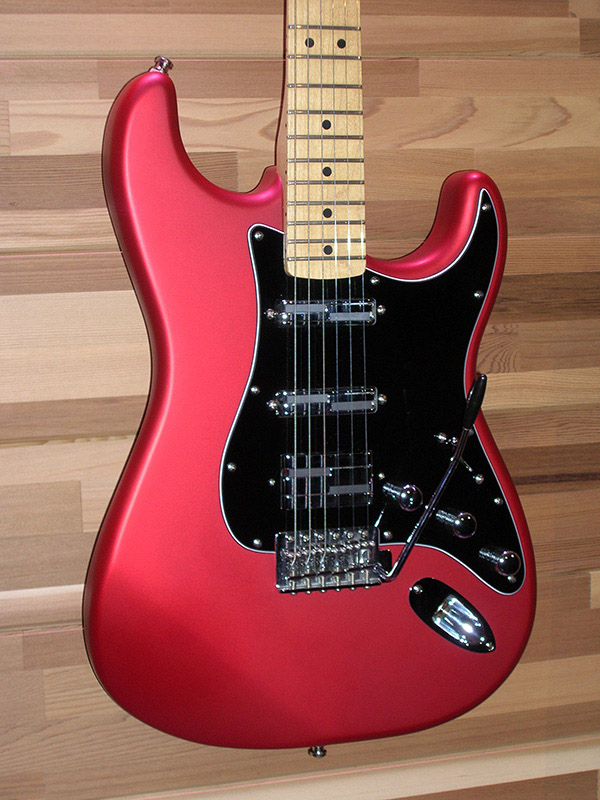
![]()
August 22, 2016
![]()
In memoriam
Jean 'Toots' Thielemans
April 19, 1922 - August 22, 2016
What is it about the year 2016? This is the fifth time this year I have to write an obituary for the death of a great artist ...
I have met Toots several times, although I never really worked with him. His musicianship and virtuosity are obviously legendary, but I remember especially his warm personality and charming smile. He just was Toots, without any airs and graces, he treated everyone with respect, with an open heart and a naturalness that I have rarely seen in others....
He became 94 years old, so the news of his death came not completely unexpected, but that makes it no less a great loss to the music world...
![]()
July 14, 2016
![]()
On June 24, 2016 I wrote the following:
If I purchase new guitars in the future this will be mainly to replace existing guitars with even better versions of the same type or to further refine the collection
And two weeks later already the time has come, my collection of guitars is even further refined and and still further expanded with...
Ba-ba-ba-baaaa...
2 new baritone guitars!
A very big acoustic/electric one...
Ibanez - AEL Series - Baritone Acoustic/Electric Guitar (tuned B to B)

This is a type of guitar that was missing in the collection: an acoustic/electric baritone guitar. And it was not so easy to find one of them, for example Takamine (my favorite brand for acoustic/electric guitars) has no baritone guitar in its range. But this Ibanez also fulfills all the requirements to be useful in the studio and it also sounds very nice, something like a lady who has smoked too many cigars :-)
And one more with roots in the 60s
and the worlds top-selling baritone electric guitar:
EASTWOOD GUITARS - Sidejack Baritone DLX Black (tuned B to B)
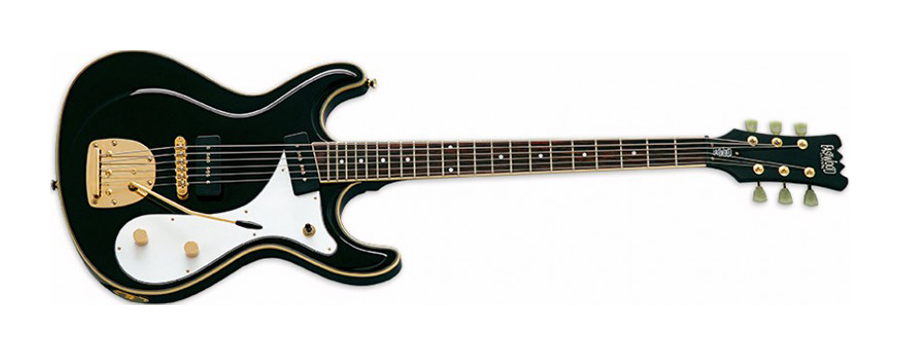
It is a brand that was not represented in my collection yet: EASTWOOD GUITARS from the USA. I discovered it more or less by accident and suddenly I found out they have the worlds top-selling baritone electric guitar in their range: the Sidejack Baritone DLX. I chose the shiny black version with gold hardware, it has has something of an old, majestic Cadillac.
Sound wise it is clearly different from the two other electric baritone guitars already present in the collection. It has less 'twang' then the GRETSCH - Electromatic® Jet Baritone Black Sparkle and is certainly not comparable with the Squier (by Fender) - Vintage Modified Baritone Jazzmaster® Antigua. This ugly duckling in the collection remains the most melodious of all three.
BTW, also the Danelectro brand is known to produce electric baritone guitars eg. the Danelectro 56, but this guitar really can't tempt me at all. Not because it would sound ugly, but mainly because these guitars are made of 'Masonite'. This is a mix of wood fibers (without glue) which is compressed under high temperature and pressure into a sheet material. It is very sensitive to moisture, can easily rot and it can't hold screws well because it is too soft. I just prefer buying guitars that are made from real wood at least...
And also a rare electric guitar with a serious personality disorder:
Fender - Artist Series - Jim Adkins JA-90 Telecaster® Thinline Crimson Red Transparent
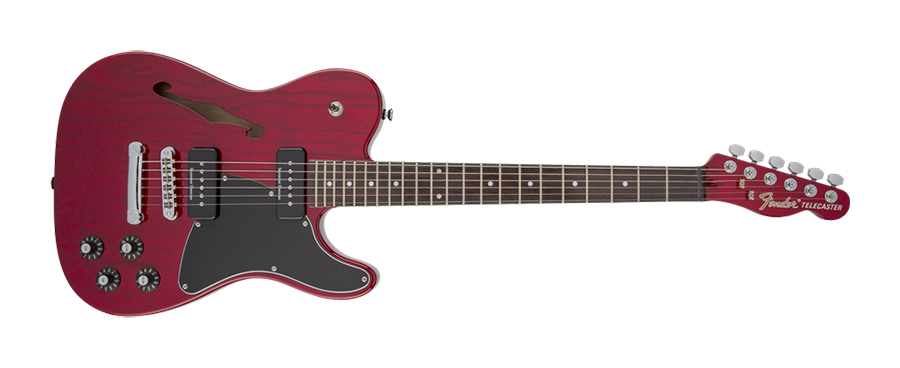
It is a brand that was not represented in my collection yet: EASTWOOD GUITARS from the USA. I discovered it more or less by accident and suddenly I found out they have the worlds top-selling baritone electric guitar in their range: the Sidejack Baritone DLX. I chose the shiny black version with gold hardware, it has has something of an old, majestic Cadillac.
Sound wise it sounds clearly different from the two existing electric baritone guitars in the collection. It has less 'twang' the the GRETSCH - Electromatic® Jet Baritone Black Sparkle and is certainly not comparable to the Squier (by Fender) - Vintage Modified Baritone Jazzmaster® Antigua. Because the ugly duckling in the collection remains the most melodious baritone guitar in the collection.
BTW, also the Danelectro brand is known for its electric baritone guitars eg. the Danelectro 56, but this guitar really can not really tempt me. Not because it would sound ugly because it isn't that bad at all, but mainly because these guitars are made of 'Masonite'. This is a mixture of wood fibers (without glue) which is compressed under high temperature and pressure into a board material. It is very sensitive to moisture, can easily rot and is too soft to firmly hold a screw. I prefer buying guitars that are at least made from real wood...
And a rare electric guitar with a strong personality
disorder: am I a Fenson... or a Gibder?
Fender - Artist Series - Jim Adkins JA-90 Telecaster® Thinline Crimson Red Transparent

The rarity of this guitar mainly refers to the fact that this is the only Fender guitar with vintage Seymour Duncan® P-90 pick-ups + it also has a vintage-style Adjusto-Matic™ bridge + an anchored-tailpiece + a scale length of 24.75" (629 mm), all of them are characteristics that are quite exceptional for a Fender guitar. Because actually... these are all characteristics of another very famous guitar brand: Gibson!
Compare the following picture of a standard Fender Classic Series 1972 Telecaster Thinline:
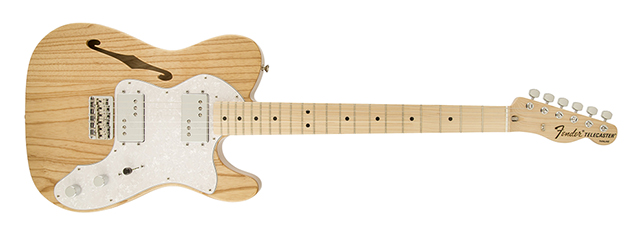
with these pictures of the three most famous Gibson models (a Gibson ES-335, a Gibson Les Paul Standard and a Gibson GS Standard):
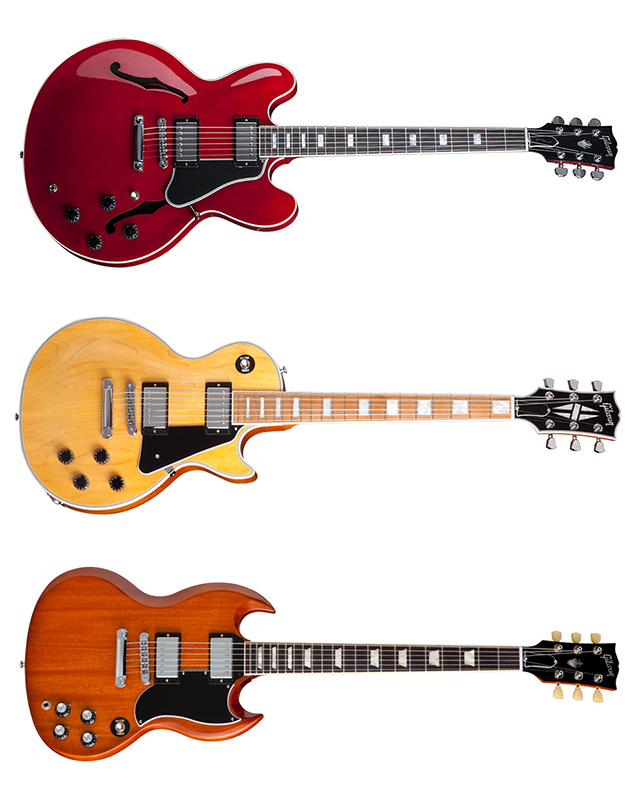
And now the Fender - Artist Series - Jim Adkins JA-90 Telecaster® Thinline Crimson Red Transparent:

I think it is very clear the Fender - Artist Series - Jim Adkins JA-90 Telecaster® Thinline Crimson Red Transparent is a hybrid between a standard Fender Classic Series 1972 Telecaster Thinline and the 3 Gibson guitars shown above.
Normally, this guitar comes in transparent lacquer, as seen on the image of the Fender Classic Series 1972 Telecaster Thinline (see above). But it also comes in the color Crimson Red Transparent, a color that is pretty unusual for a Fender guitar. That's why I chose this color and actually my guitar has a very nice grain which is clearly visible through the translucent crimson lacquer.
In terms of sound it is warmer and fuller than a standard Fender Telecaster® however the P-90 pick-ups it also gives the necessary aggressiveness to rock, but is not really suitable for heavy heavy metal.
BTW, a few words about the Artist Series and Signature guitars in my collection: I don't necessarily buy them because I'm a fan of the artists or the bands they play in. However, I have found these guitars just have a better finish in general, as if the quality control is better than on the standard versions + usually they also use a higher quality of the individual parts. I therefore believe that the premium price you pay is not so much for that famous name or signature, but for the superior quality. Of course, you can also ask the question whether a famous artist would associate his name with an inferior guitar, it wouldn't be a smart move anyway. Also important: these guitars always have one or more features that are not standard and therefore they become particularly interesting for use by the customers in the studio.
So, nevertheless I suspect it will take quite some time now until I will expand the collection with yet another new guitar. Partly because I simply do not have any more free space left to hang it on the guitar wall or even to put it on a guitar stand, secondly because I really do not know what type of guitar I should add anyway.
Logically, the summary list of all the guitars in my guitar collection in my post of June 24, 2016 is no longer correct, this is the new list including the three new guitars:
Acoustic and acoustic/electric guitars (Spanish style):
- Takamine - Pro Series 5 - Acoustic/Electric Guitar (metal 6 string)
- Takamine - Pro Series 3 - Acoustic/Electric Guitar (metal 12 string)
- Takamine - Pro Series 3 - Acoustic/Electric Guitar (nylon 6 string)
Acoustic/electric baritone guitar (Spanish style)
- Ibanez - AEL Series - Baritone Acoustic/Electric Guitar (tuned B to B)
Acoustic/electric bass guitars (Spanish style):
- Ibanez - Acoustic/Electric Grand Concert Bass Guitar Open Pore Natural
- Takamine - G Series - Acoustic/Electric Bass Guitar Brown Sunburst
Electric guitars (hollow body /semi-hollow body):
- GRETSCH - Tim Armstrong Signature Electromatic® Hollow Body Matte Vintage Maho Stain Black
- GRETSCH - Electromatic® Hollow Body 12-String Sunburst
- GRETSCH - Electromatic® Semi-Hollow Body Center-Block Rosa Red
Electric guitars (solid body):
- ESP Ltd - AX Series - Battle Axe Black
- ESP Ltd - Signature Series - James Hetfield Truckster Guitar Aged Black Satin
- Fender - Artist Series - Jim Adkins JA-90 Telecaster® Thinline Crimson Red Transparent
- Fender - Artist Series - Kurt Cobain Jaguar® NOS 3-Color Sunburst
- Fender - Artist Series - Jimi Hendrix Stratocaster® Black
- Fender - Artist Series - Chris Shiflett Telecaster® Deluxe
Arctic White
- Fender - Artist Series - Troy Van Leeuwen Jazzmaster® Oxblood
- Fender - Standard Stratocaster® - Olympic White - 50th Anniversary Edition - custom upgraded with
3 x Fender Custom Shop ’69 Strat single-coil pickups
- Fender - Standard Stratocaster® - Candy Apple Red MN - custom upgraded with an EMG Pro Series System DG20 'DAVID Gilmour'
- Gibson - Les Paul Studio Manhattan Midnight
- Gibson - SG Standard Heritage Cherry - custom upgraded with a Gibson Angus Young Signature Humbucker Bridge Pickup
- Jackson Guitars - Pro Series - Dinky™ Chlorine Burst
- Squier (by Fender) - Classic Vibe Stratocaster® 50s 2-Color Sunburst MN
- Squier (by Fender) - Classic Vibe Telecaster® 50s Butterscotch Blonde
Electric baritone guitars (solid body):
- EASTWOOD GUITARS - Sidejack Baritone DLX Black (tuned B to B)
- GRETSCH - Electromatic® Jet Baritone Black Sparkle (tuned B to B)
- Squier (by Fender) - Vintage Modified Baritone Jazzmaster® Antigua (tuned A to A)
Electric bass guitars (solid body)
- ESP Ltd - Forest Series - Forest Bass Black (5 strings - low B)
- Fender - Artist Series - Marcus Miller Jazz Bass® Natural
- Fender - Artist Series - Roger Waters Precision Bass®
- Squier (by Fender) - Vintage Modified Jazz Bass® V Natural (5 strings - low B)
- Squier (by Fender) - Vintage Modified Precision Bass® V Olympic White
(5 strings - low B)
- Squier (by Fender) - Vintage Modified Bass VI 3-Color Sunburst (6 strings - tuned 1 octave lower then a conventional guitar)
There are also 3 guitars from a lower price range for rehearsal purposes and that I use personally to learn how to play the guitar:
- Jasmine (by Takamine) - S-34C II acoustic (metal 6 string)
- Squier (by Fender) - Affinity Series™ - Stratocaster® HSS Burgundy Mist
- Squier (by Fender) - Affinity Series™ - Precision Bass® PJ Metallic Red
The completely renewed list with all the details about the collection of guitars and basses can be found at:
![]()
June 24, 2016
![]()
Our 'guitar wall' welcomes three new guitars:
A guitar from the Stone Age...
Fender - Artist Series - Troy Van Leeuwen Jazzmaster® Oxblood
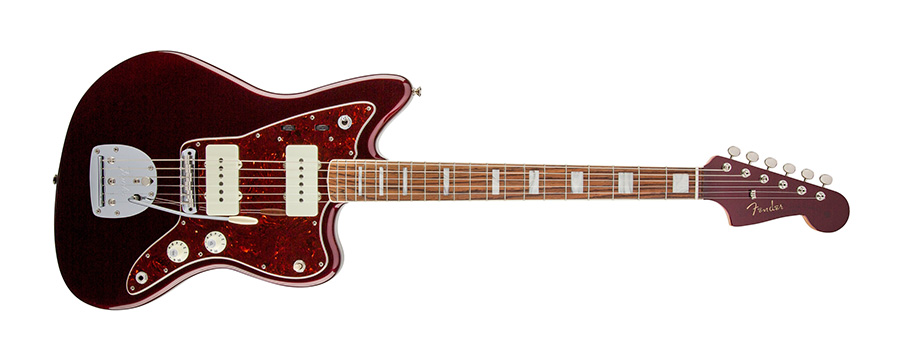
Troy Van Leeuwen is guitarist in the bands Queens of the Stone Age and Eagles of Death Metal.
This guitar is in addition to the Fender - Artist Series - Kurt Cobain Jaguar® NOS 3-Color Sunburst I have since my birthday. I had no Jazzmaster® in the collection yet, but I didn't want a standard version with the typical shortcomings of a Jazzmaster® eg. a Jazzmaster® bridge where the strings sometimes pop out of the saddles. This guitar has a Fender - Mustang® bridge so the strings remain much better in place. This guitar is therefore suitable for both delicately jazzy guitar playing and for the serious rock player.
And a very ugly guitar with a beautiful
'bari-tone'

Squier (by Fender) - Vintage Modified Baritone Jazzmaster® Antigua (tuned A to A)
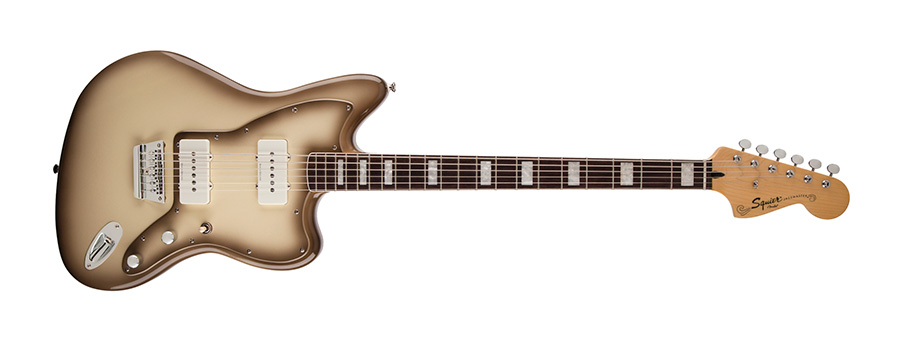
I really do not like its color, the color 'antigua' looks, depending on the lighting, something like a mix of snot green and vomit brown, but what a beautiful sound is hidden in this guitar!
It's also a Jazzmaster® but manufactored by Squier (by Fender) and what makes it very special is that this is a real baritone guitar. So it has a longer neck and strings than a standard guitar and is tuned a fifth lower than a normal guitar (A D G C E A). This baritone guitar is therefore ideally suited to double standard guitars, with the same finger positions as a on normal guitar it sounds exactly one fifth lower.
The sound is deep, warm and full and sits inbetween a guitar and a bass guitar (think about eg. the theme from Twin Peaks by Angelo Badalamenti).
And another baritone guitar, but one
with a fairly high glitter to it

GRETSCH - Electromatic® Jet Baritone Black Sparkle (tuned B to B)
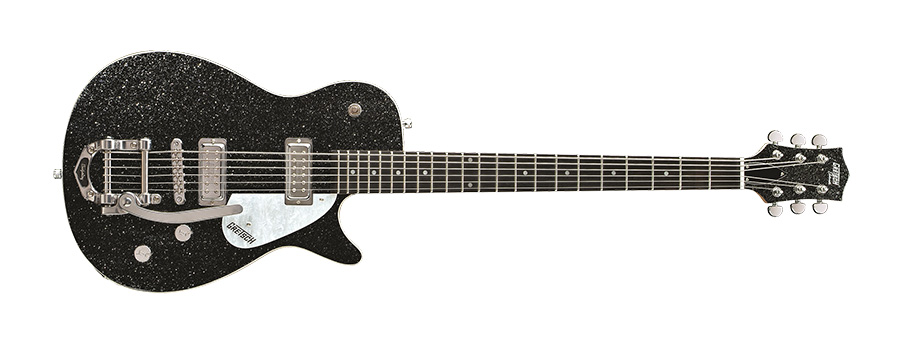
After the purchase of the Squier (by Fender) - Vintage Modified Baritone Jazzmaster® AntiguaI'm a bit in love with the sound of baritone guitars and I went looking for other baritone guitars. Soon I came in contact with a whole range of 7- and 8-string guitars specifically designed for heavy-metal. These guitars are also called baritone guitars because in addition to the standard six strings they also have one or two additional strings tuned lower. I even found one with 10 strings and a range of 6 octaves (tuned A D G B E A D G B E):
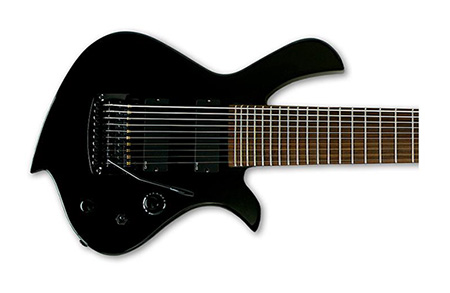
This type of guitars was clearly not what I was looking for...
After a long search, I have found a sparkling GRETSCH - Electromatic® Jet Baritone Black Sparkle. This is a true baritone guitar with a longer neck and strings than a standard guitar but is tuned a fourth lower than a normal guitar (B-E-A-D-F♯-B), although it can also be tuned a fifth lower just fine (A D G C E A). Soundwise this guitar has more 'twang' and tends to be more suited for country, surf music from the sixties and the typical sound of the music in spaghetti westerns.
For some time also have a Squier (by Fender) - Vintage Modified Bass VI 3-Color Sunburst, sometimes this guitar is also counted among the baritone guitars, but this is not correct. Although it has six strings that are thinner than standard strings on a bass guitar and also the neck is a bit shorter than that of a bass guitar. But instead of being tuned a quarter or a fifth lower it is tuned a full octave lower than a standard guitar just like every bass guitar. So it has only a higher frequency range than a bass guitar due to the two additional upper strings, but it is not tuned in another other key like baritone guitars. Besides in the official name is stated '"Bass VI", it is even a type designation, so it's definitely not a baritone guitar. FYI: the Bass IV is the favorite instrument of Robert Smith and therefore typical to the sound of The Cure.
BTW, actually baritone guitars are being used in many genres of music ... they are even considered to be the secret weapon of many diverse artists ,especially in the studio when recording... and now also here in the studio...
But please do not spread the news!
Thus, the guitar wall is occupied entirely by guitars, bass guitars and acoustic guitars are now neatly stored on separate guitar racks. So basically the planned investment program for guitars ends here.
If I purchase new guitars in the future this will be mainly to replace existing guitars with even better versions of the same type or to further refine the collection. At present, they are all very decent, new guitars and basses from the mid to upper price range (from €500 to €2.000). However, the chances are very small that I will purchase instruments from the highest price range (from €2.000 to €7.000) or start buying historic instruments (from €3.000 to ... ). Because I know from experience that a guitar that costs 10 times the price does not necessarily sounds 10 times better, on the contrary...
Usually the more expensive guitars are particularly aesthetically more beautiful by using exclusive woods and they usually show a better finish in the details. For live use or the real guitar collector, this may be justified, but not for guitars used in the studio for recordings. For example Gibson has in their range besides their very expensive Les Paul Standard and Custom models also some cheap 'Les Paul Studio' models available. Literally the name 'Studio' comes from the idea that this model would be sonically indistinguishable from a Les Paul Standard or Custom in the recording studio, and that the flashier guitars would be reserved for stage use only. As a matter of fact, while selecting all guitars that I bought for the studio I have used that same point of view, het uiterlijk is minder van belang, it's the sound that counts (see fe.. the very ugly Squier (by Fender) - Vintage Modified Baritone Jazzmaster® Antigua)
In any case, if you look at the entire list, I almost have the 'complete history of the guitar' available in the studio, or at least the most famous types:
Acoustic and acoustic/electric guitars (Spanish style):
- Takamine - Pro Series 5 - Acoustic/Electric Guitar (metal 6 string)
- Takamine - Pro Series 3 - Acoustic/Electric Guitar (metal 12 string)
- Takamine - Pro Series 3 - Acoustic/Electric Guitar (nylon 6 string)
Acoustic/electric bass guitars (Spanish style):
- Ibanez - Acoustic/Electric Grand Concert Bass Guitar Open Pore Natural
- Takamine - G Series - Acoustic/Electric Bass Guitar Brown Sunburst
Electric guitars (hollow body /semy-hollow body):
- GRETSCH - Tim Armstrong Signature Electromatic® Hollow Body Matte Vintage Maho Stain Black
- GRETSCH - Electromatic® Hollow Body 12-String Sunburst
- GRETSCH - Electromatic® Semi-Hollow Body Center-Block Rosa Red
Electric guitars (solid body):
- ESP Ltd - AX Series - Battle Axe Black
- ESP Ltd - Signature Series - James Hetfield Truckster Guitar Aged Black Satin
- Fender - Artist Series - Kurt Cobain Jaguar® NOS 3-Color Sunburst
- Fender - Artist Series - Jimi Hendrix Stratocaster® Black
- Fender - Artist Series - Chris Shiflett Telecaster® Deluxe
Arctic White
- Fender - Artist Series - Troy Van Leeuwen Jazzmaster® Oxblood
- Fender - Standard Stratocaster® - Olympic White - 50th Anniversary Edition - custom upgraded with
3 x Fender Custom Shop ’69 Strat single-coil pickups
- Fender - Standard Stratocaster® - Candy Apple Red MN - custom upgraded with an EMG Pro Series System DG20 'DAVID Gilmour'
- Gibson - Les Paul Studio Manhattan Midnight
- Gibson - SG Standard Heritage Cherry - custom upgraded with a Gibson Angus Young Signature Humbucker Bridge Pickup
- Jackson Guitars - Pro Series - Dinky™ Chlorine Burst
- Squier (by Fender) - Classic Vibe Stratocaster® 50s 2-Color Sunburst MN
- Squier (by Fender) - Classic Vibe Telecaster® 50s Butterscotch Blonde
Electric baritone guitars (solid body):
- GRETSCH - Electromatic® Jet Baritone Black Sparkle (tuned B to B)
- Squier (by Fender) - Vintage Modified Baritone Jazzmaster® Antigua (tuned A to A)
Electric bass guitars (solid body)
- ESP Ltd - Forest Series - Forest Bass Black (5 strings - low B)
- Fender - Artist Series - Marcus Miller Jazz Bass® Natural
- Fender - Artist Series - Roger Waters Precision Bass®
- Squier (by Fender) - Vintage Modified Jazz Bass® V Natural (5 strings - low B)
- Squier (by Fender) - Vintage Modified Precision Bass® V Olympic White
(5 strings - low B)
- Squier (by Fender) - Vintage Modified Bass VI 3-Color Sunburst (6 strings - tuned 1 octave lower then a conventional guitar)
There are also 3 guitars from a lower price range for rehearsal purposes and that I use personally to learn how to play the guitar:
- Jasmine (by Takamine) - S-34C II acoustic (metal 6 string)
- Squier (by Fender) - Affinity Series™ - Stratocaster® HSS Burgundy Mist
- Squier (by Fender) - Affinity Series™ - Precision Bass® PJ Metallic Red
The completely renewed list with all the details about the collection of guitars and basses can be found at:
![]()
June 10, 2016
![]()
Patience is a nice virtue!
Op October 25, 2015 I wrote what follows on my news page:
However, there is one small thing that is still missing in my V-Synth Collection and that is a "Roland VC-1 V-Card". This is a PC-card which transforms an original V-Synth in a legendary Roland D-50 synthesizer. These are two pictures:
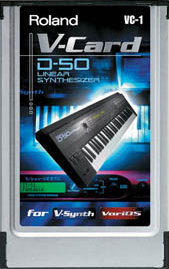
a Roland VC-1 V-Card
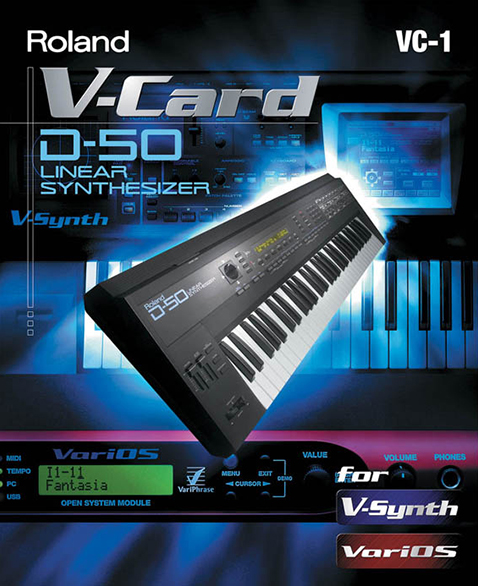
the front of the package
The Roland V-Synth XT (19" rack unit) has the VC-1 V-Card built-in, but buying a full V-Synth XT synthesizer specially for the VC-1 V-Card a is a bit too much I'm afraid...
So if you should see Roland VC-1 V-Card for sale, please let me know ASAP!
Of course I kept searching ans searching... and look what I received a few days ago from Japan:

So from now on is listed on the equipment list with all my synthesizers:
Roland - D-50 - Linear Synthesizer (vintage 1987) - Roland VC-1 V-Card
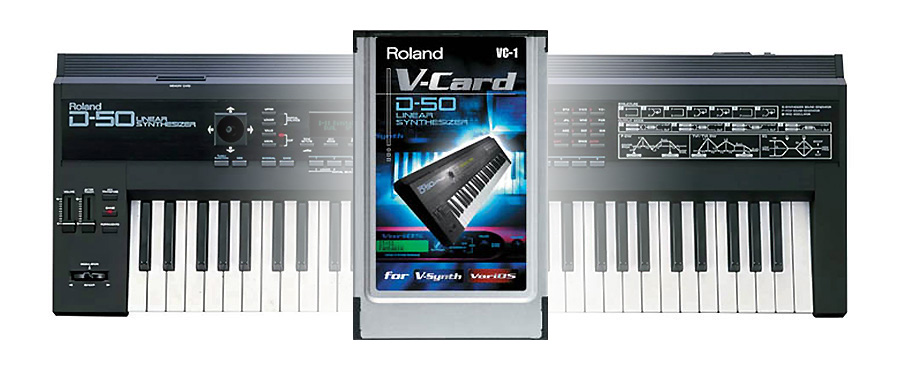
- Roland VC-1 V-Card for Roland V-Synth and VariOS
- PC Card turns the V-Synth into a complete and accurate reconstruction of Roland’s groundbreaking D-50 L/A Synthesizer
- digital Linear Arithmetic Synthesizer with 8-16 voices
- mono timbral
- Digital LAS (Linear Arithmetic Synthesis) & PCM Samples
- low-pass resonant TVF filters
- preset memory: 6 banks x 64 patches = 384 and includes all original presets like “Fantasia,” “Living Calliope” and “Intruder FX”
- internal (user) memory : 8 banks x 64 patches = 512
- full programmability using the V-Synth’s touchscreen, knobs and sliders
- TimeTrip Pad serves as D-50’s Partial Balance joystick
- original D-50 Patches can be loaded via MIDI bulk dump
![]()
April 21, 2016
![]()
In memoriam
Prince Rogers Nelson
(Prince - O(+> - TAFKAP)
June 07, 1958 - april 21, 2016
"Sometimes it snows in April
Sometimes I feel so bad, so bad
Sometimes I wish life was never ending
And all good things, they say, never last"
What is it about the year 2016? Again I have to write an obituary for the death of a great artist...
I have seen Prince live several times, the first was on August 27, 1986 in Forest National in Brussels with his band The Revolution during the Under the Cherry Moon Tour (of Parade Tour). I was 19 years old and was very impressed by the music and the show, and especially the fact that Prince was so small in stature. I remember it very well: I stood near the podium,Prince began the concert remaining backstage while singing, a few minutes long a great voice came from the speakers... and suddenly a little guy came on stage! Undoubtedly he was made entirely of soft rubber, because I had never seen anyone on stage dancing and playing the guitar as gymnastic and erotic as he did, not mentioning the real dancers he had next to him, it was incredible!
The last time I saw Prince live was in 2010 at Werchter Boutique, an outdoor concert. There I experienced one of the best concert moments ever in my life... It was very bad weather all day long and the concert began under a threatening sky with very dark clouds with thunderstorms in the distance. This storm slid silently across the festival site, the whole audience knew what was hanging over their heads, it was a fairly bizarre and apocalyptic atmosphere. When the dark clouds were hanging right above our heads and it started to rain very hard Prince suddenly started the song 'Purple Rain', he shouted to the people controlling the light-show to make all the spotlights shine a purple light and to aim them at the audience. And as if by magic the pouring rain changed in beautiful purple rain... and there I danced with my beloved, it was an unforgettable moment... And a year later we were married...
Thank U Prince, thank you to have written a large part of the soundtrack to my youth...
![]()
April 10, 2016
![]()
Today I celebrated my 49th birthday!
These are my birthday gifts:
An exceptional guitar...
Fender - Artist Series - Kurt Cobain Jaguar® NOS 3-Color Sunburst
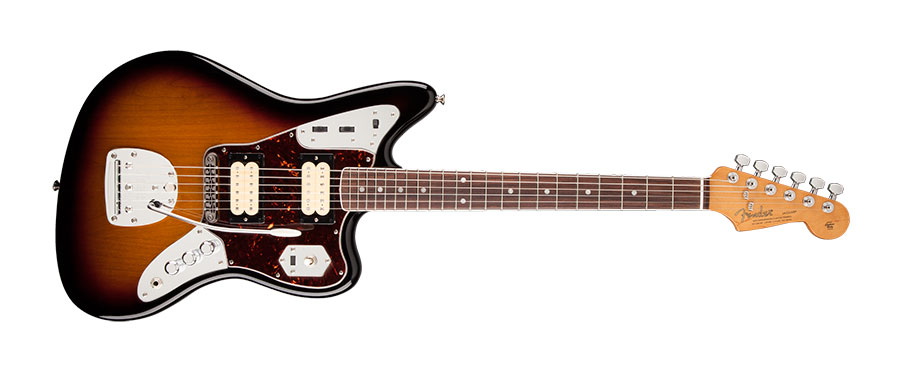
Undoubtedly this is a guitar that needs little explanation, it is the legendary Kurt Cobain Jaguar!
Technically, this guitar is an identical copy of Kurt Cobains favorite guitar in NOS (New Old Stock) version, including the non-standard components and the right pickups. On the ocCASIOn of 20 years 'Nevermind' by Nirvana this guitar had already been released in 2011 in a Road Worn version on which also all the cosmetic damage was replicated into the smallest detail. But I already own a Road Worn version of a James Hetfield Truckster and the consciously made fake damage never really charmed me. I spent a lot of attention to my collection of guitars and try to keep them in the best possible condition, so the Road Worn and Relic craze is really not my cup of tea.
Therefore I was very pleased to se Fender recently released the Kurt Cobain Jaguar NOS version, including the 100% authentic sound of this iconic guitar but without the ragged 'grunge' look, I love it!
BTW, this guitar was delivered by courier on April 5, afterwards I discovered this was the same date that Kurt Cobain committed suicide...
Including two related guitar FX pedals...
Boss - DS-1 Distortion
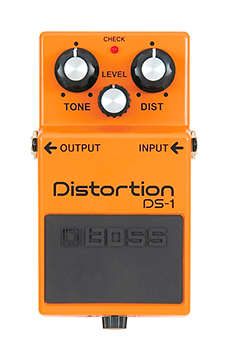
electro-harmonix - 4800 Small Clone Chorus
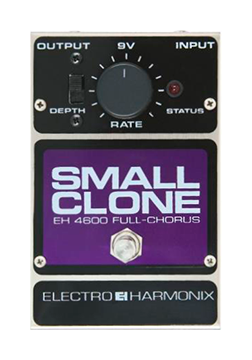
These pedals are inseparable from Kurt Cobain, because the Boss DS-1 Distortion and the electro-harmonix Small Clone Chorus are responsible for the typical guitar sound of Kurt Cobain and Nirvana. Nearly the whole album 'Nevermind' was recorded with them.
And another exceptional guitar...
Fender - Artist Series - Jimi Hendrix Stratocaster® Black
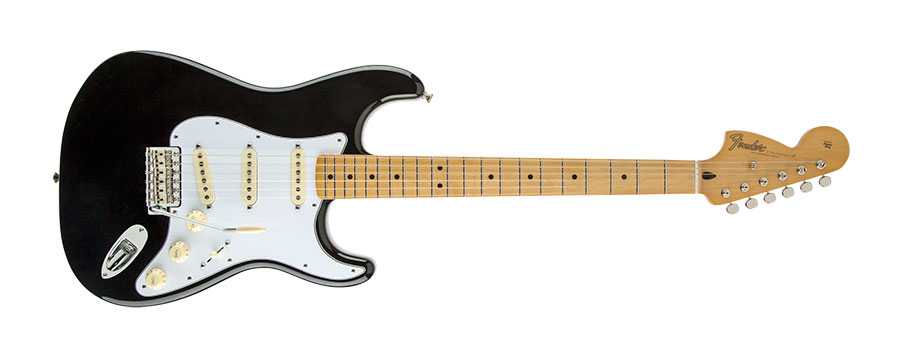
Undoubtedly this is also a guitar that needs little explanation, it is a Jimi Hedrix Stratocaster!
This is a rather bizarre guitar built according to a special concept devised by Fender to re-create as good as possible the typical guitar sound of Jimi Hendrix. It is not a copy of a guitar of Jimi Hendrix, but more like a tribute to Jimi Hendrix and especially for right-handed guitarists.
Jimi Hendrix was in fact left-handed and played right-handed guitars with the strings upside down. This wasn't very convenient, becaue the guitar was hanging completely upside down, only the strings were positioned correctly. However 'correctly' is not quite the right word, because of course the string length was the other way around, now the low E string was the longest string instead of the high E string and vice-versa. As a result the strings tend to bend easier, which explains some of the typical guitar sound of Jimi Hendrix.
Fender has obtained this special effect of reverse string lengths by constructing a right-handed Stratocaster with a neck and headstock of a left-handed Stratocaster, allowing the strings being upside down indeed. But also the guitar pickups were put upside down, what is correct again considering the use of a right-handed guitar by a left-handed guitarist. The tremolo lever however stiil hangs below the bridge (a right-handed guitar played upside down has the tremolo lever above the bridge which is not very convenient), what benefits the playability of this guitar very much.
There was a choice of a white or black version, I already own a white Stratocaster from 1996 which aged very beautyful, so buying a black one was the most logical choice. But I also have chosen the black one because the white one actually only refers to the white guitar that Jimi Hendrix used at the Woodstock festival in 1969, while a black Stratocaster was actuallyhis favorite guitar (also known as 'Black Beauty'.
Including three related guitar FX pedals...
Dunlop - 535Q Cry Baby® Multi-Wah

Dunlop - Jimi Hendrix Fuzz Face Mini Distortion

electro-harmonix - Big Muff Pi Deluxe
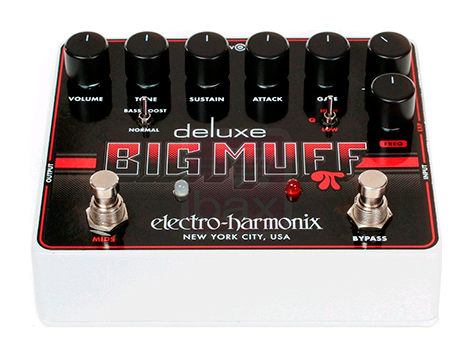
These three pedals are inseparable from Jimi Hendrix.
First and foremost a Dunlop 535Q Cry Baby® Multi-Wah pedal, these days there is a large choice of many different Dunlop Cry Baby® modells, there is even a Cry Baby® Jimi Hendrix Signature available. But after long consideration I have chosen a Dunlop 535Q Cry Baby® Multi-Wah pedal. This pedal not only gives the typical Jimi Hendrix sound, but you can also opt for other settings allowing to use this pedal for a lot of music genres (it has a 6-position switch and control knobs). This wah pedal is considered to be the Swiss Army Knife of Wah pedals.
The second pedal is the Dunlop Jimi Hendrix Fuzz Face Mini Distortion. Jimi Hendrix used the legendary Dallas Arbiter Fuzz Face which nowadays is only available as the Dunlop Jimi Hendrix Fuzz Face Distortion. However, this is a very large pedal with the original (reversed) input-output connectors and the only possibility to power it is by using a 9V battery. The Jimi Hendrix Fuzz Face Mini Distortion however has exactly the same electronic components as its big brother, is 2/3d smaller in size, has the standard output-input connectors like all recent guitar FX pedals and a connector for a 9V DC power adaptor. Therefore I have chosen the recent mini version because it's just much more convenient to use then the original big one.
Finally, there is also a electro-harmonix Big Muff Pi Deluxe. Jimi Hendrix used the legendary NYC Big Muff Pi which nowadays is only available as the electro-harmonix Big Muff Pi. However, I have chosen the electro-harmonix Big Muff Pi Deluxe, this version is identical to the original electro-harmonix Big Muff Pi, but is extended with some extra features like a noise gate and a filter. This pedal is also not only known by Jimi Hendrix, but is also responsible for the guitar sound of Carlos Santana and DAVID Gilmour.
OK, I think both guitars are a nice addition to the collection, they are at least different enough from the standard versions to be interesting for guitar players who come to the studio. And the five related guitar FX pedals are the icing on the (birthday) cake!
![]()
March 22, 2016
![]()

In memoriam
Brussels - march 22, 2016
![]()
March 09, 2016
![]()
In memoriam
Sir George Martin
03 januari 1926 - 08 maart 2016
Sir George Marin was a record producer, arranger, composer, conductor, audio engineer and musician. And of course he was world famous as producer of The Beatles and artists like Ella Fitzgerald, Peter Gabriel, Sting, Meat Loaf, Celine Dion, Elton John and Kate Bush. As a producer he won 7 Grammy Awards and he had 30 number-one hit singles in the United Kingdom and 23 number-one hits in the United States.
I had the honor to attend a few producers workshops by Sir George Martin and I only have good memories of Sir George Martin and his inspiring workshops. Together with the workshops by Tony Visconti (producer of DAVID Bowie) they laid the foundation for my personal career in the music business. Upon today I still use a lot of their working methods as producer and audio engineer in my studio
![]()
February 27, 2016
![]()
New acquisitions for 2016:
A new microphone for voice recording
with a legendary logo badge
NEUMANN TLM 49 vocal microphone
cardioid large diaphragm condenser microphone
Why this microphone?
- it uses the famous K 47 capsule of the legendary NEUMANN M 49 and U 47
- it has a transformerless design with less coloration
- it has has a warm sound which is especially optimized for vocal performance
- it won the 2006 TEC Award in the category MICROPHONE TECHNOLOGY / RECORDING
It is certainly the perfect complement for my NEUMANN U 87ai and all my other high end studio microphones
And symphonic strings to be treated with respect
Vienna Dimension Strings 1
175.8 GB (or more then 830,000 samples)
of the most excellent sounds of symphonic strings available today!
The Vienna Symphonic Library (VSL) is probably the largest sample library in existence today contains more then 1000 GB of data or more then 2 million samples, of course with an accompanying price tag of more than 10,000 euro for the entire collection. This collection includes a full symphonic orchestra with a very 'classical' sound to it and is thus ideal for composing classical music. Therefore, the collection is actually less suitable for pop and rock music.
However, a few years ago VSL started all over again from scratch by recording new samples and they developed Vienna Dimension Strings 1. VSL has developed a completely different concept here as opposed to the standard collection of samples of solo instruments and instrument groups. Quite simply explained they recorded separately eight musicians actually playing together on a 'silent stage'. As a result you really have eight different musicians at your disposal and each one of them is entirely 'controllable' by MIDI. For each musician you can determine the bowing technique he uses, how many errors he plays, how far his pitch deviates from being in tune, how much human feeling is being expressed, etc... This is a totally different approach then the traditional 'sampled strings' we all know and use. This also makes this collection ideal for use in popular music and contemporary classical music.
Meanwhile, also Vienna Dimension Strings 2 is in development and already partly available, recorded on the same principle, but played “con sordino” (with muted strings). Perhaps this collection will also be purchased, although "con sordino" strings are not being used so that very much in popular music
And a software update of a full symphonic orchestra that can be called legendary at least
MIROSLAV PHILHARMONIK 2
The most emotional orchestral collection ever!
This collection is at least as famous as the aforementioned Vienna Symphonic Library, but much more affordable, at least on present day. I have been working since 1996 with the symphonic orchestra collection by Miroslav Vitous. Originally this was a collection 5 CD-ROMs x 650 MB = 3,25 MB (= 0,00325 GB) of data for SampleCell II and other samplers. This collection had a price of 200.000 BEF or 5.000 euro, I was one of the few that owned this collection.
In 2005 it became clear that the music software company IK Multimedia teamed up with Miroslav Vitous and the Czech Philharmonic Orchestra, because suddenly 'MIROSLAV PHILHARMONIK' became available as a separate Virtual Instrument plugin. This collection contained 7 GB of data and more than 1,300 instrument patches and just for a tenth of the original price. This was obviously a very major advancement in capabilities, sound palette and also in terms of pricing.
Until IK Multimedia presented 'MIROSLAV PHILHARMONIK 2' last December 2015, the logical successor to 'MIROSLAV PHILHARMONIK'. Today this plugin contains 55 GB of data and more then 2.300 instrument patches. The special feature of this collection has always been that a lot of emotion is contained in the original recordings, What makes this collection less 'classical' than some other virtual symphony orchestras such as VSL. Therefore, this collection is perfect for film scores. And still not as expensive as you might expect
And two software updates for people who have some trouble to sing in tune...
![]()
February 08, 2016
![]()
In memoriam
Robert "Berre" Bergen
November 24, 1962 – February 07, 2016
![]()
January 10, 2016
![]()
In memoriam
David Robert Jones
(David Bowie)
January 08, 1947 - January 10, 2016
"Oh, I'll be free
Just like that bluebird
Oh, I'll be free
Ain't that just like me?"
(last words of the song 'Lazarus')
Many years ago I had the honor to meet him in to his Wisseloord Studios in Hilversum (NL) and I witnessed some recording sessions. This was very impressive to me, especially the technical and production side of things. I learned a lot, David Bowie himself, I do not remember so well. To me he was just one of the musicians who were present in the recording room, and I was particularly interested in the microphone setups and the buttons on the giant mixer.
Later I have seen him a few times live on stage and over the years I have come to appreciate his work more and more and now I admire him very much now for what he has meant to the music world.
I also bought his last album 'Black Star' (I pre-ordered it so I already heard the music before his obituary) and this music and lyrics are so impressive, none other than Daid Bowie could include his impending death as well as he has done (he was terminally ill for some time). It is to be silent... very silent...
Respect!
![]()

![]()
![]()
Copyright © 1995-2025 by Delta Music Belgium • Dolby Atmos Music Studio • Rummenweg 30 • 3800 Sint-Truiden • Belgium
All Rights Reserved
Privacy notification and cookie policy
All product names, logos, and brands are property of their respective owners.
All company, product and service names used on this website are for identification purposes only.
Use of these names, logos, and brands does not imply endorsement.
![]()









